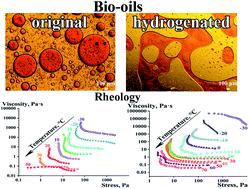当前位置:
X-MOL 学术
›
Sustain. Energy Fuels
›
论文详情
Our official English website, www.x-mol.net, welcomes your feedback! (Note: you will need to create a separate account there.)
Rheological, thermophysical, and morphological features of original and hydrogenated bio-oils
Sustainable Energy & Fuels ( IF 5.6 ) Pub Date : 2021-08-05 , DOI: 10.1039/d1se00567g Anastasiya Y. Yadykova 1, 2, 3, 4 , Sergey O. Ilyin 1, 2, 3, 4
Sustainable Energy & Fuels ( IF 5.6 ) Pub Date : 2021-08-05 , DOI: 10.1039/d1se00567g Anastasiya Y. Yadykova 1, 2, 3, 4 , Sergey O. Ilyin 1, 2, 3, 4
Affiliation

|
Bio-oils are multicomponent heterogeneous systems with different origins and prehistory, which implies that they have a complex rheological and thermophysical behavior. The high viscosity of bio-oils is the reason for their special treatment, including hydrogenation, which affects the structure, properties, and, accordingly, the possibility of using the resulting products as liquid fuels. This makes it important to understand the relationship between the structural features of bio-oils and their rheology. In this study, the rheological behavior of four samples of original and hydrogenated bio-oils was studied in a wide temperature range from −30 °C to 70 °C. Bio-oil samples exhibited viscoelasticity and were characterized by the presence of a yield stress, the value of which depended on the content of the dispersed phase in the bio-oil and the type of continuous medium. From a morphological point of view, the original bio-oils represented water-in-oil emulsions, while the hydrogenated samples were oil-in-water ones. According to differential scanning calorimetry data, bio-oils tended to undergo significant supercooling and did not exhibit phase transitions when cooled to at least −50 °C. Arrhenius activation energies can be used to express the tendency of bio-oils to undergo viscosity increase and structure formation (leading to the appearance of a yield stress) with varying the temperature. It was shown that hydrogenated bio-oils have a lower yield stress and apparent viscosity measured at high shear stresses. The complex rheological behavior of bio-oils makes it incorrect to characterize them by a single viscosity value, since it depends not only on the phase composition of the bio-oil, but also on the measuring conditions, which must be tailored individually, taking into account future bio-oil applications.
中文翻译:

原始和氢化生物油的流变、热物理和形态特征
生物油是具有不同起源和史前史的多组分异质系统,这意味着它们具有复杂的流变学和热物理行为。生物油的高粘度是对其进行特殊处理的原因,包括加氢,这会影响结构、性能,并因此影响将所得产品用作液体燃料的可能性。这使得了解生物油的结构特征与其流变学之间的关系变得非常重要。在这项研究中,研究了四种原始和氢化生物油样品在 -30 °C 至 70 °C 的宽温度范围内的流变行为。生物油样品表现出粘弹性,并以存在屈服应力为特征,其值取决于生物油中分散相的含量和连续介质的类型。从形态学的角度来看,原始生物油代表油包水乳液,而氢化样品是水包油乳液。根据差示扫描量热法数据,生物油往往会经历显着的过冷,并且在冷却至至少 -50 °C 时不会出现相变。Arrhenius 活化能可用于表达生物油随温度变化而发生粘度增加和结构形成(导致出现屈服应力)的趋势。结果表明,氢化生物油在高剪切应力下具有较低的屈服应力和表观粘度。
更新日期:2021-08-09
中文翻译:

原始和氢化生物油的流变、热物理和形态特征
生物油是具有不同起源和史前史的多组分异质系统,这意味着它们具有复杂的流变学和热物理行为。生物油的高粘度是对其进行特殊处理的原因,包括加氢,这会影响结构、性能,并因此影响将所得产品用作液体燃料的可能性。这使得了解生物油的结构特征与其流变学之间的关系变得非常重要。在这项研究中,研究了四种原始和氢化生物油样品在 -30 °C 至 70 °C 的宽温度范围内的流变行为。生物油样品表现出粘弹性,并以存在屈服应力为特征,其值取决于生物油中分散相的含量和连续介质的类型。从形态学的角度来看,原始生物油代表油包水乳液,而氢化样品是水包油乳液。根据差示扫描量热法数据,生物油往往会经历显着的过冷,并且在冷却至至少 -50 °C 时不会出现相变。Arrhenius 活化能可用于表达生物油随温度变化而发生粘度增加和结构形成(导致出现屈服应力)的趋势。结果表明,氢化生物油在高剪切应力下具有较低的屈服应力和表观粘度。



























 京公网安备 11010802027423号
京公网安备 11010802027423号